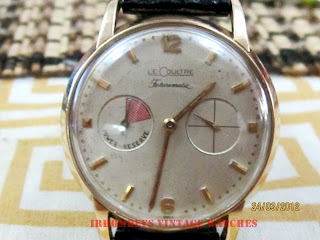
DIAL: CHAMPAGNE WITH NICE CRACKED PATINA
CROWN: UNSIGNED GP CROWN
BEZEL: -
BAND/TALI : NEW GENUINE BROWN LEATHER BAND FIT 8" WRIST
HIDDEN LUGS SIZE: 20mm
BAND WIDTH: 20mm
WATER RESISTANT: NOT STATED
Brief History of Glashutte Watches
Glashutte Original was created in 1845, when the German master watchmakers, Ferdiand Al Lange, Julius Assmann, Ludwig Strasser, Johannes Durrstein, Adolf Schneider, Strasser and Rohde, Ernst Kassiske settled in the region of Glasshutte. These master watchmakers were awarded various gold model at the world exhibition and international competitions, thus creating the foundation and reputation of watching making industry of Glashutte. In 1878, Moritz Grossmann founded the German School of Watchmaking, hence building groundwork for more skillful watchmakers in the region of Glashutte and transforming the region into a reputed symbol of watchmaking excellence.
In the beginning of World War II, the watch manufactories in Glasutte was still in the production of military watches for the Navy and Air Force. Later, in the last day of War World II, Glashutte was bombed from the sky and the factories were badly destroyed. The reminding unaffected factories merged and found the VEB Glashutter Uhrenbetriebe under the rule of East German state.
When the communist German Democratic Republic found its end as a souvereign state, the state-owned “Glashuetter Uhrenbetrieb” (GuB) was busy developing a new selfwinding movement. Solid it should be, and efficient. Before the works could be finished, the company was sold to the French movement manufacturer France Ebauches SA. This company tried to save itself from bankruptcy by means of German know-how and the cheap labour in Eastern Germany. The new selfwinding movement should compete with the Swiss movements produced by ETA, and was therefore developed specifically with a high momentum and maximum universality in mind. Before the short-time owner of the Glashuette watch manufactory had to develop a new movement, they found already a good movement in Glashuette: In 1978, the V.E.B. ("Volkseigener Betrieb" = People's owned company) Glashuetter Uhrenbetriebe (GUB) brought out their last completely new construction, the cal. 11-26, dubbed Spezichron.
This Spezichron was modernized in several steps under control of first the France Ebauches, then the Treuhand-Anstalt, and finally of Heinz W. Pfeifer, until it found its way as cal. 10-30 into the new watches of Glashuette Original. Under control of the Treuhandanstalt, which, from 1990 to 1994, took over the former East German state-owned companies and sought to bring them into the private sector, the movement cal. 10-30 was completed and used in a new and very cheap line of watches after 1993.
Yet there were plans for more complications, which could not be based on the trusted 10-30 movement; a new development was necessary. However, it was neither economically feasible nor desirable to have completely new cases and dials produced for the new base movement. Therefore, the starting point of the effort was the condition, that the new movement had the same dimensions, as well as the location of important parts, such as the winding stem, must be the same as in the old 10-30. Additionally, the planned new complication modules should have enough space on the movement’s front.
All elements of the 10-30 movement, which were tried and reliable, were taken over into the new construction, above all the complete escapement was transferred. Even these parts were refined, however, with the addition of a swan neck adjustement, for example. The result of the development was the new cal. 39 movement, which from the outside, looked like the old 10-30. Yet of the originally 130 parts, only 17 remained unchanged. The new movement had more jewels, a better adjustment, and, above all, a better ability to wear additional complication modules.
With the 10-30, every module had to be autonomous; that means, that each module had to consist of an upper an a lower baseplate, so that the final movement had four plate layers. The new cal. 39 movement was constructed in a way that its upper baseplate could serve as the lower base of the module, resulting in a “sandwich” of only three plate layers. This saves space which can be used for more complicated modules.
Finally, the optical qualities of the new movement were drastically improved: skeletonized rotor, finely grinded wheels, angled plates and teeth, the decoration work entirely done by hand. In spite of the still solid base of a movement designed to compete with the ETA-workhorses, the Glashuette Original cal. 39 without doubt is one of the finest selfwinding movements on the market.
The cal. 26 movement found in the watches of UNION/Glashuette, is based on that cal. 39 movement, but is changed in two essential ways: It consists of 12 parts less than its GO counterpart (mainly in the fine adjustement area), and its decoration is mostly machine-made. This saves a lot of money and enables UNION, to offer fine inhouse movements in well-made, competitively priced watches.
Yet there were plans for more complications, which could not be based on the trusted 10-30 movement; a new development was necessary. However, it was neither economically feasible nor desirable to have completely new cases and dials produced for the new base movement. Therefore, the starting point of the effort was the condition, that the new movement had the same dimensions, as well as the location of important parts, such as the winding stem, must be the same as in the old 10-30. Additionally, the planned new complication modules should have enough space on the movement’s front.









































